1963 Belgian Grand Prix race report: Clark vanquishes field in Spa spray
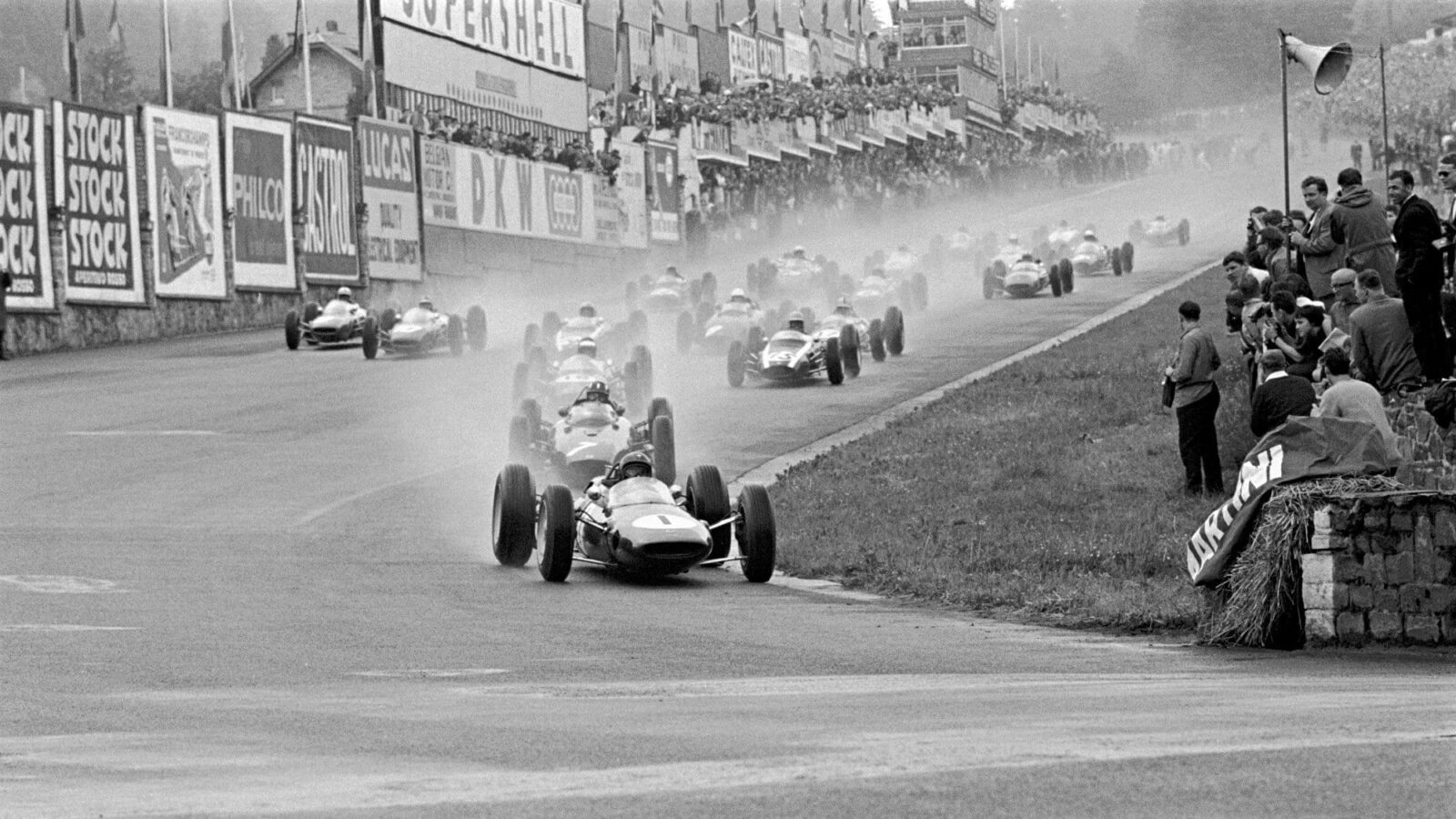
Clark leads the field in the wet at Spa
Klemantaski Collection/Getty Images
The second of the 1963 Grande Epreuves took place on the super-fast Spa-Francorchamps circuit, nowadays not such a billiards-table as it used to be, and with patches of new surface where last winter’s frost had caused damage. Nevertheless the wonderful circuit retains all its magic and its challenge to drivers who can corner at really high speeds and to designers who think their cars are fast.
The circuit is really too fast for a 1½-litre car, it being possible to keep almost flat-out all the way from the top of the Burnenville down through Malmedy, round Stavelot and back through the fast swerves to La Source. If you have a good road-holding chassis and a skilled driver then your engine must be strong to withstand full throttle for some three minutes, or if you have a very powerful engine then you want a skilled driver to keep his foot right down, through some of the fast bends.
The lap record still stands to Brabham with a 2½-litre Cooper-Climax in 3min 51.9sec at a speed of 218.287kph, the best 1½-litre lap being by Clark in a Lotus-Climax V8 in 3min 55.6sec, a speed of 215.449kph, set up in last year’s race, so that by normal standards of progress Clark’s time could be beaten, but Brabham’s unlikely as the lower bhp of the present-day cars is really felt on the long uphill drag from Stavelot to La Source.
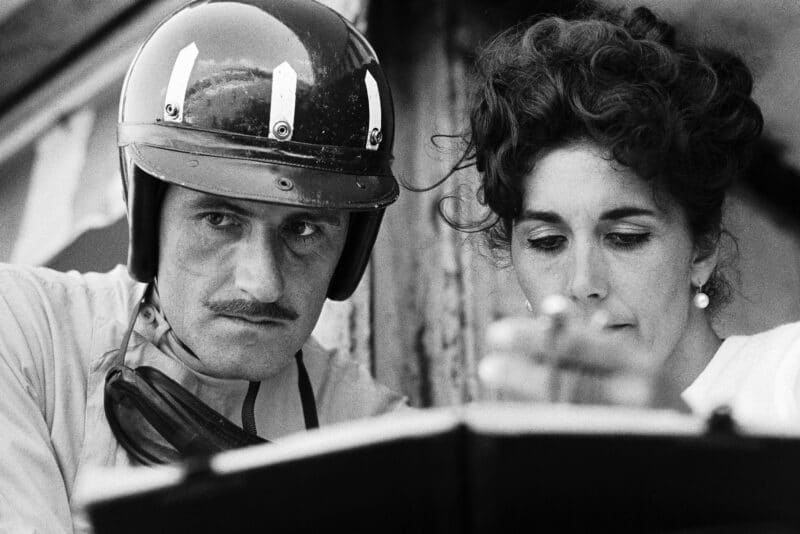
Bette Hill verifies the laptimes of her husband Graham.
Motorsport Images
An excellent entry was received and most teams were assured of two cars starting, one or two of the lesser lights having to go fast enough in practice to justify their acceptance, but there was no question of any “bumping” from the grid. Practice was only on Friday and Saturday, which never seems to be enough for such a fast circuit on which final detail tuning can make a lot of difference, and one where high-speed aerodynamic experiments could be usefully carried out. Conditions were fine and dry for the first evening though the circuit was still damp in patches from early rain, the new bits of surface seeming to retain the water rather a long time.
Team Lotus were out with their two Lotus 25 cars used at Monaco, Clark in the new one and Taylor in the older one, and they had their spare Lotus 25 with them as a stand-by, this still using an old carburetter Climax V8, whereas the other two were the latest short-stroke fuel-injection models. Clark’s car had an interesting experimental windscreen layout, where the Perspex was cut down to scuttle height, an opening made at the front of the screen and the fibre-glass scuttle being moulded to deflect the air upwards, as it came under the screen, and form a jet of high-speed air up and over the driver’s head so that he sat in still air, looking forward over the front of the car with no part of the Perspex screen in his vision.
The British Racing Partnership arrived with their brand new stressed-skin “monocoque” car that they had designed and built themselves, it being fitted with a fuel-injection BRM V8 engine and 5-speed Colotti gearbox. This was for Ireland, their number one driver, and was called a BRP-BRM V8; with so much British about the name it was a pity it was painted pale green instead of British Racing Green. However, its finish and standard of workmanship was first class and a credit to the team, and it arrived direct from some satisfactory testing at Goodwood where it had covered some 50 trouble-free laps. They had a Lotus 24 with BRM injection engine and 6-speed Colotti gearbox for Jim Hall, their second driver.
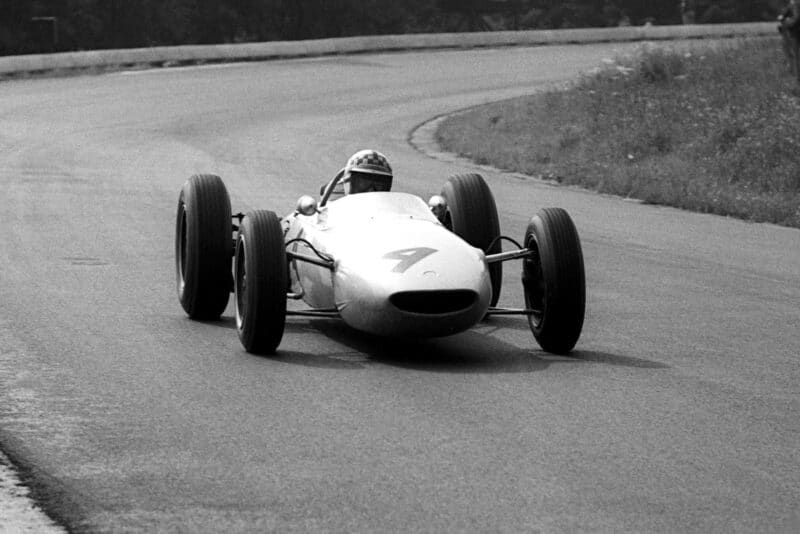
Innes Ireland qualified the new BRP Mk1 in an encouraging seventh place, but retired after nine laps with gear selection problems.
Motorsport Images
The BRM team had their usual two cars, though Ginther’s was fitted with a new 6-speed gearbox of BRM design, which is destined for the 1963 car when it is completed. This box has its six forward speeds controlled by a left-hand lever in the cockpit operating a selector mechanism on the gearbox, and on the right of the gearbox is another selector mechanism, controlled by another lever which selects reverse gear when it is required, although for their first try-out the reverse lever and control were not fitted. As at Monaco they had an earlier car as a spare.
The two works Ferraris for Surtees and Mairesse were as used at Monaco, except that detachable nosepieces were screwed onto the radiator cowl, presenting a smaller air entry in the interests of high-speed drag. The Cooper team had also thought about the question of high speeds and McLaren’s car was fitted with a new nose cowling and wrap-round Perspex windscreen of very slim outline and very pretty shape, the sides of the cockpit sloping inwards until they almost touched the driver’s helmet. The second works Cooper was of normal shape, the two cars being those used at Monaco, with injection Coventry-Climax V8 engines. Bonnier was driving Rob Walker’s usual 1962 Cooper-Climax V8.
There were two Brabham-Climax V8 cars for “the patron” and Gurney, the former car having a 6-speed Colotti gearbox fitted, the latter a Brabham converted VW unit, both cars having rebuilt Climax V8 engines. Reg Parnell was present with his covey of Lolas, young Chris Amon having the latest one and the Belgian driver Lucien Bianchi having an earlier one, both with carburetter Climax V8 engines. Although two Sciroccos were entered only one arrived, to be driven by Settember, and was receiving finishing touches in the paddock long after practice began.
Two ATS cars were entered but there was no sign of them when practice got under way, although the team-manager was expecting them, and it was said that they were delayed on the road. Finally there were two private-owners, Siffert with his Lotus-BRM and de Beaufort with his old 4-cylinder Porsche. The Swiss driver had repaired his BRM V8 engine after its blow-up at Monaco and had welded the crankcase where the rod had broken through, and was keeping his fingers crossed.
Qualifying
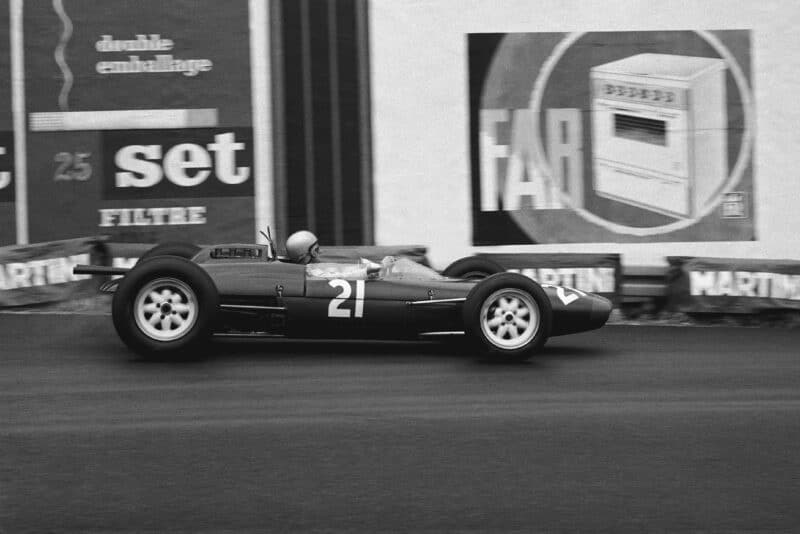
Chris Amon in his Lola Mk4A Climax.
Motorsport Images
The paddock was very full and very busy long before the roads were closed to the public, and when practice began at 5pm almost everyone was ready to go and drivers began feeling their way round the high-speed circuit, a welcome change after the slowness of Monaco, though Clark and Gurney were no doubt wondering where all the power and speed had gone in their “Mickey-mouse” Grand Prix cars after driving at Indianapolis. Until lap times began to get below 4min there was no real need to get very excited, but the odd damp patches of new surface were holding most people back for quite a time.
Almost unbelievably, after Monaco, Clark was again in trouble with his ZF gearbox, and it was not long before he was looking very upset while the internals of the gearbox were spread out on the pit counter. On the other hand, Taylor was quite happy and circulating steadily, as was the Cooper number two driver Tony Maggs, who was the first to break 4min, his car going very well, though McLaren was not so happy. The two Ferraris were getting too hot in the oil department and this was causing the pressure to drop, which would eventually lead to bearing trouble.
“Clark and Gurney were no doubt wondering where all the power and speed had gone in their “Mickey-mouse” Grand Prix cars after driving at Indianapolis”
On the odd laps that Clark was able to do, his wind-deflector on the scuttle seemed to work satisfactorily, giving him a strange sensation of unobstructed vision but “heavy” objects such as flies, stones or rain-drops were likely to penetrate the air barrier, so it did not seem that it was going to prove practical.
The BRMs were not going unduly fast and Ginther was having trouble with the new gearbox, having to hold the gear-lever in position and drive one-handed, which was not conducive to fast laps. The new BRP car was in gear-change trouble and while some modifications were made Ireland went out in the team’s spare Lotus-BRM V8. Jim Hall was lapping steadily, finding his way round the circuit and already going fast enough to satisfy his qualification for a place on the starting grid.
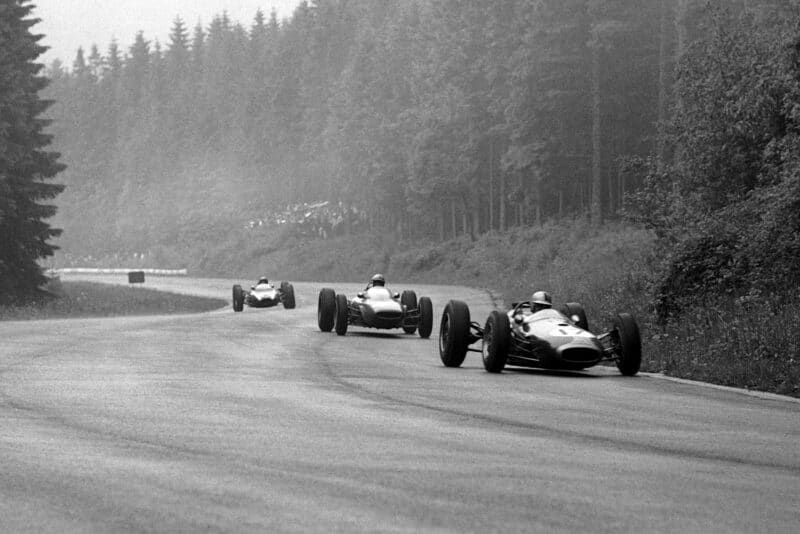
Jack Brabham in a Brabham BT3, he retired with a fuel injection pump failure.
Motorsport Images
Jack Brabham was really getting under way but Gurney was not too happy with the handling of his car and was having the lower wishbones unscrewed to reduce the castor-angle, it being compared to Brabham’s car “by eye”. For quite a long while it was Maggs who was setting the pace but then Brabham began to try very hard and took the lead, and Mairesse pressed on regardless and showed that the Ferraris were fast even if they were not right.
Surtees was worried about the temperatures and not too convinced about the brakes, but was happy with the handling, and Bonnier was going quite well in the Rob Walker Cooper. Clark was still in and out with gearbox problems and went out for a few laps in the spare car, and finally Settember got under way in the Scirocco-BRM.
Practice was almost over when a strange car was seen to go by the pits, making a noise not previously heard on the circuits. It was an ATS with Phil Hill driving, the transporter having arrived on the other side of the circuit and unloaded there with just time for two exploratory laps, and a few minutes later Baghetti appeared briefly in the second ATS. It had not been an exciting practice and Mairesse was fastest with 3min 56.2sec, while only four more drivers managed to break the 4min mark.
On Saturday practice was soon after lunch and much work had been accomplished by then, for BRM had replaced the old 5-speed gearbox on Ginther’s car, BRP had fitted Lotus wheels, hubs and suspension uprights to their “monocoque” car as it was not handling as well as they wanted, and the Lotus assemblies gave a narrower track and the Lotus wheels had smaller width rims.
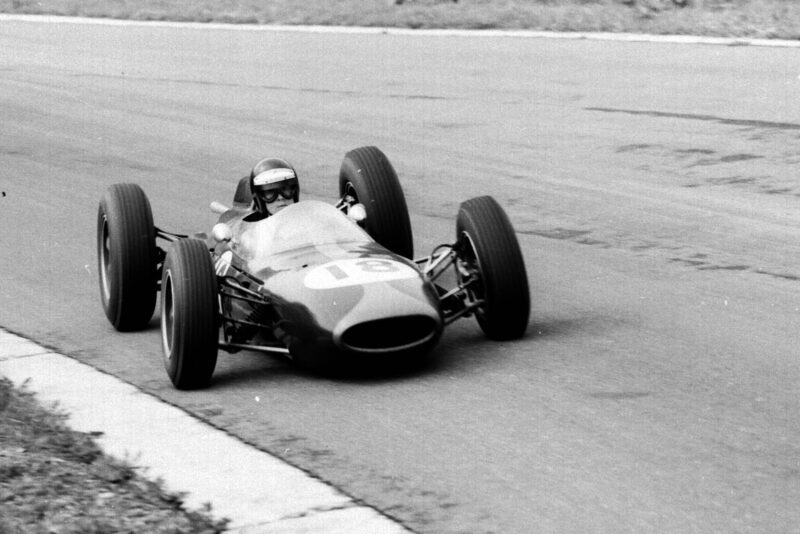
Dan Gurney in his Brabham BT7 Climax.
Motorsport Images
The Walker team had finished off a brand new Cooper for Bonnier which comprised a 1963 chassis like the works cars, with water and oil breathings in the tubes, the driving seat being an aluminium fuel tank, and it had a brand new Coventry-Climax V8 engine with single-plane crankshaft layout like BRM which allowed simple uncrossed exhaust pipes. Mated to this new engine was a brand new Colotti Type 34 Mark II gearbox with six speeds and right-hand selector mechanism. A large bolt limited the travel of the clutch pedal, so that the leverage ratio would not bend the operating mechanism on the clutch itself. The bodywork, painted Walker blue, was similar to the works Coopers, with turned-up end to the engine cover and completely exposed gearbox and final drive. The team had their 1962 Cooper out as well, the new one being strictly on-test only.
“In this practice BRM began to get going and it was Graham Hill who recorded the best time”
In this practice BRM began to get going and it was Graham Hill who recorded the best time, in 3min 54.1sec, which improved on the existing record by quite a bit, the average speed being 216.830kph (approx 134mph), which is good going considering the lap includes a 30mph hairpin. Under 4min laps soon became the order of the day among the fast boys, and Ireland was going very fast with the BRP, its handling greatly improved, and he got down to 3min 56.9sec quite early in the afternoon. Gurney was in great form and made second fastest time of the day, and Mairesse improved on his previous time.
Clark was still sitting about waiting for his gearbox to be put right yet again, and meanwhile Taylor was putting in a great number of laps and was well under 4min. Maggs was still going faster than his team-leader and Bonnier and Jim Hall just failed to beat the 4min barrier, while Siffert was going well for a private owner amongst all the professional teams. The Scirocco was handling satisfactorily but was down on power, and there was a similar situation in the ATS camp, Phil Hill being delighted, if not surprised, by the handling and road-holding but feeling he needed more bhp as the rpm would fall off peak all too easily. Poor de Beaufort only just began practice when his engine broke, and Bonnier took the new Cooper out but the engine would not run properly so he returned to the old one.
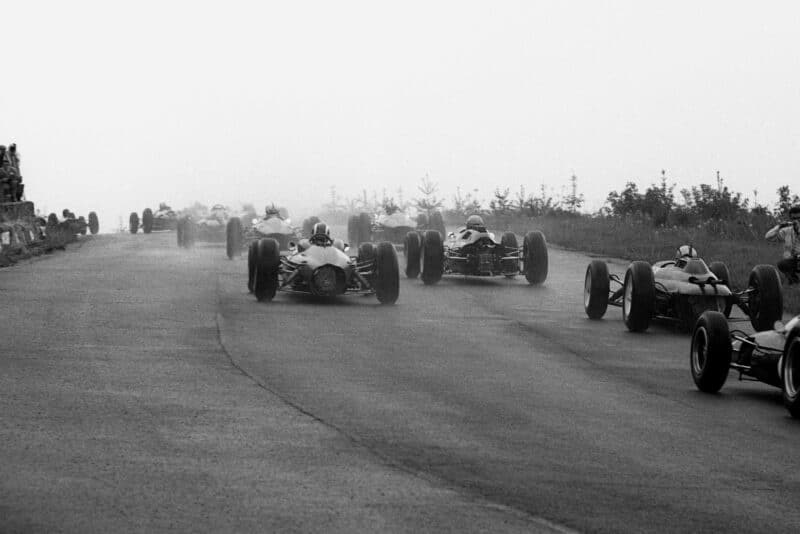
The competitors climb through Eau Rouge in tricky wet conditions at the start; a keen photographer on the right getting very close to the action.
Motorsport Images
Team Lotus were so busy with Clark’s gearbox that they seemed to have forgotten about Taylor and he did a great number of laps, enjoying himself immensely, until on one lap, while rounding the fast Stavelot bend, something at the rear end broke, though it was never revealed what it was, and the car spun through 360 degrees, struck a low wall head-on and bounced off into a wooden observation hut, the Lotus badly wrecked and Taylor stepping out shaken and bruised. He returned to the pits and numbers were hastily put on the spare car and he went out again to ensure that the car did sufficient qualifying laps. Clark’s car was finally sorted out and he was able to put in a number of consecutive laps, but was not in the running for the front row of the grid.
The results of the two days of practice showed a surprisingly large difference in lap times among the top drivers, almost whole seconds of difference being the order of the day rather than tenths of a second. Saturday night saw de Beaufort driving back to Stuttgart to fit another engine, Team Lotus tidying up the spare car for Taylor to use and inspecting the wreckage of the crashed car rather gloomily; Ferraris were anything but confident; Coopers felt that they were all right, and BRM were pretty satisfied, while Brabham’s team were delighted at having Gurney on the middle of the front row and BRP were well satisfied with the performance of their new car, Ireland being very enthusiastic about it.
Race
The whole of Sunday morning saw rain, rain and more rain, with thunder and lightning and a mild cloudburst, and even at lunchtime as the crowds arrived for the 3:30pm start it was still raining and the racing cars were prepared under umbrellas, tarpaulins and in the shelter of the transporters. Final checks were made, tanks filled, tyre pressures adjusted and so on, with rain drizzling down; however, about 2pm the weather looked as though it might improve.
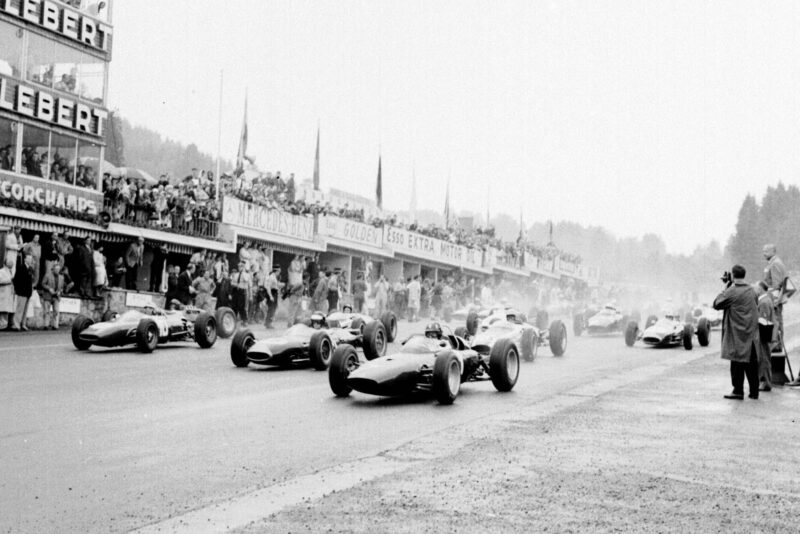
Graham Hill (BRM P57), Dan Gurney (Brabham BT7 Climax) and Willy Mairesse (Ferrari 156) lead at the start of the race.
Motorsport Images
By the time the drivers had been taken round on a parade lap, some in the passenger seats of sports cars, others in the luxurious rear seats of open Mercedes-Benz and so on, and the Grand Prix cars were assembled on the grid the weather was drying rapidly, and it seemed as if the track would be fairly dry for the race.
Clark had had a normal windscreen fitted to his Lotus, Taylor was badly bruised on his leg but was ready to start in the old Lotus 25 with the carburetter engine, Ireland was sticking to the Lotus wheels on the BRP, and de Beaufort had arrived back from Stuttgart with a new engine in his Porsche. The start at Spa is slightly downhill so all the cars had bits of rubber or small stones to chock them so that drivers did not have to hold the cars on the handbrake, and as the flag fell it was expected that Mairesse would jump into the lead, but he was “out-jumped” by Clark who, from the third row, went outside everybody, down the pit-lane, and dived into the lead as the field crossed the Eau Rouge river bridge, and was first away up the hill to Burnenville. Graham Hill and Brabham were following him and by the end of the first lap Clark and Hill had pulled out 15 sec. lead over the rest of the runners, who were all nose-to-tail, led by Brabham, Gurney and Mairesse, with Jim Hall and Baghetti bringing up the rear.
“It was expected that Mairesse would jump into the lead, but he was “out-jumped” by Clark who, from the third row, went outside everybody, down the pit-lane”
On the second lap Clark and Graham Hill stayed together but widened the gap from the rest to 22sec, so that one began to wonder if there was anyone else in Grand Prix racing! Mairesse was on his own in third place, with Brabham, McLaren, Gurney and Surtees in a row for fourth place. Then came Ginther, not too happy with the handling of his BRM on the damp parts of the track, and already a fair-sized gap had appeared before Amon and Maggs went by.
As the tail-enders braked for La Source hairpin Bianchi and de Beaufort collided, the Lola’s fibreglass nose being split, so that the Belgian had to stop at the pits and have it cut away, while the Dutchman went on with only a slight dent in the Porsche’s bodywork. The only serious change on lap three was that Surtees passed Gurney, but farther back Ireland was recovering ground, having inadvertently switched off the ignition of the BRP while changing gear away from the start, so that he got boxed in amongst Bonnier and Siffert. With the Lola nose damage snipped away Bianchi was back in the race, but a long way back, and as the leaders came down to La Source to finish lap four, with the leading Lotus and BRM even farther out on their own, Mairesse overdid his braking and had to go straight on.
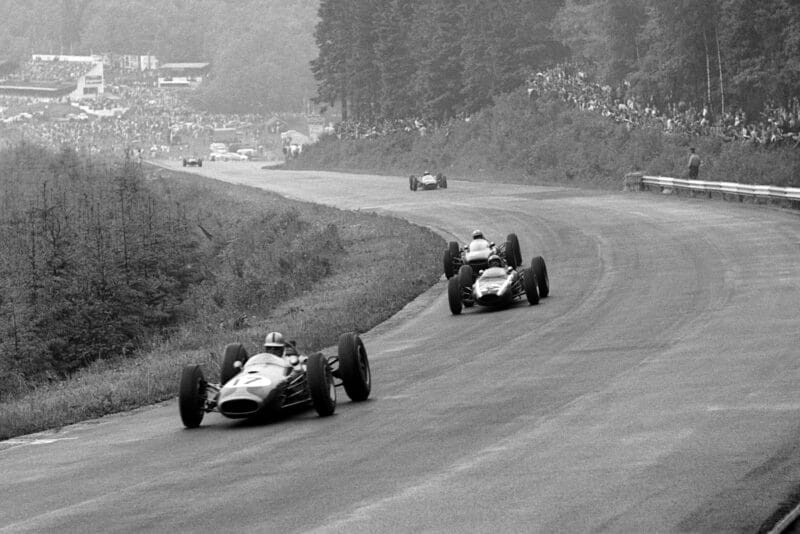
Jack Brabham in his Brabham BT3.
Motorsport Images
By the time he got sorted out Brabham, Surtees, McLaren and Gurney were rounding the hairpin, and Willy wasted no time in forcing his way into the middle of the group. Chris Amon was going well and catching Ginther, but oil was coming from the rear main bearing of the Lola’s Climax engine and was burning on the exhaust pipes, leaving a trail of smoke. Phil Hill was getting worried about a lack of heat in the ATS cockpit, indicating that the cooling water was not circulating forwards to the radiator. He stopped to report this and an air lock was relieved and he went off again, but was still not happy as the single throttle-spring was broken and the pedal was not returning rapidly.
Clark went by at the end of lap five with eight seconds lead over Graham Hill and these two were still in a class of their own. Brabham, Surtees and McLaren went by in an orderly fashion but Mairesse was overdue and the Ferrari drew into the pits not running on all six cylinders, while Gurney went by. Amon had passed Ginther and then the rest appeared some while later, but first Siffert stopped at his pit to investigate “funny steering” and he was followed by Baghetti, with gearbox problems, Taylor to retire from the fray with quoted “low oil pressure” and Bianchi with the tattered Lola.
After a lot of fiddling about with the fuel-injection system Mairesse was sent out again, the engine sounding just as ragged, and after two laps with no improvement he returned to the pits to retire, Mr. Bosch being blamed for the lack of six good cylinders. Ireland came into the pits with his gear-change linkage adrift at the gearbox end and sat about while a broken part was welded and refitted, and Siffert was in again trying to solve his unstable front-end problem.
Meanwhile Clark was drawing steadily away from Graham Hill, but the damp track was keeping the average speed down to a bare 200kph, there being no sign of Clark breaking 4min for a lap. Brabham was having an intermittent short-circuit in his fuel pump circuit, and first Surtees overtook him and then McLaren, and on lap eight he stopped at his pit, to try and find the fault. Phil Hill was back again to have a moan about the broken throttle spring and it seemed as if the whole race was going to centre around the pits, for both Ireland and Siffert were in again. Baghetti had come to rest with no drive between the engine and the rear wheels, a shaft having broken somewhere in the gearbox, Amon had to give up before all his oil went and the engine was ruined, and Brabham was in and out trying to cure his electrical fault.
“Clark was drawing steadily away from Graham Hill, but the damp track was keeping the average speed down to a bare 200kph”
At 12 laps Clark was 15sec in the lead and could afford to ease up a little as everything seemed to be working well, and Surtees, in third place, was gaining a little on Graham Hill, but the Ferrari did not last and on lap 14 he drew into the pits with his engine not running properly. In the early laps McLaren had been well in the running, but as the roads dried and the pace speeded up he realised that the Cooper’s engine was not pulling on all eight cylinders and he went by the pits indicating with his fingers that he was a cylinder short, to explain why Gurney had got by and was pulling away. Surtees was a long while at the pits while the Ferrari mechanics fiddled with the engine, but it wasn’t doing much good and they had no engineers with them to supervise any critical adjustments.
Clark at last managed a lap in exactly 4min, just before half-distance, and he did his 16th lap, which was half-way, in 3min 58.1sec, but then the rain began to fall. Graham Hill was still lying second but 26½ sec. in arrears and having no hope of catching the flying Lotus, and 45sec later came Gurney in a very firm third position. Before the rain began Ginther and McLaren were having a little private race together and behind them Maggs and Bonnier were engaged in the only serious race of the day. The remaining six runners had all been lapped and Phil Hill had come to rest out on the circuit with something quite simple having broken in his ATS transmission, as he had heard no noise but had merely come to rest with no drive.
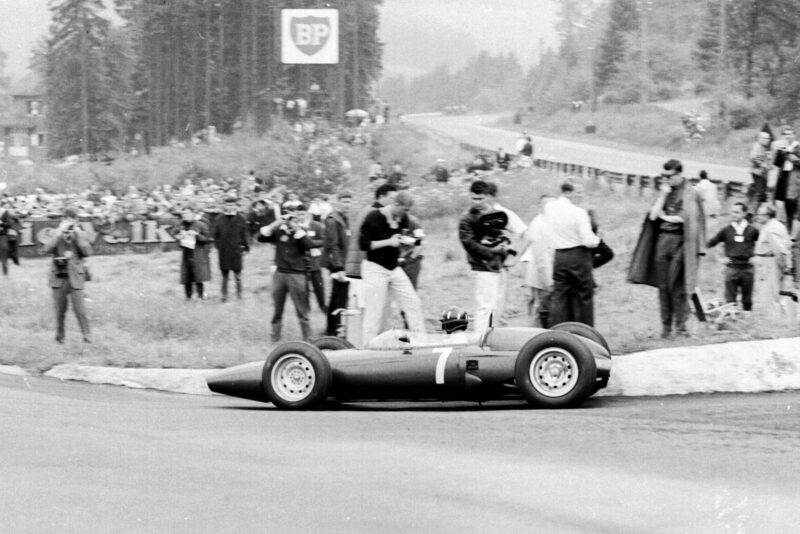
Graham Hill (at the wheel of his BRM P57)
Motorsport Images
On lap 17 a heavy storm was brewing over the hills towards Malmedy, with black clouds gathering and flashes of lightning rending the sky. Graham Hill’s BRM went by sounding very peculiar and that was the last that was seen of it for it came to rest out on the circuit with a broken gearbox, and then the storm started to break. Jim Hall and Bianchi were going downhill towards Malmedy on a dry road when suddenly the road was awash and they were both spinning helplessly, the pale green Lotus going right off the track into a field and the Lola spinning along the bank but finishing up on the road undamaged. Reports came back from excited observers that the two cars had collided but this was quite untrue, though they had both crashed at the same moment. Jim Hall’s car was too badly damaged to continue, but Bianchi returned to the pits to remove the mud and grass and check for damage, and then to continue.
With Graham Hill’s BRM broken down, Clark was way out on his own in the Lotus, with Gurney more than a minute and a half behind. Clark was driving impeccably, never putting a wheel wrong on the treacherous, slippery roads, and then the rains began to come as never before. On the high parts of the course clouds were down to ground level and torrential rain began to fall all round the circuit, great stretches of it being like a river bed.
Ginther, whose BRM had been set up with camber angles and toe-in to suit dry roads, just had to give up and tour round, letting the two works Coopers of McLaren and Maggs go by, and then let Clark lap him. Behind the BRM came Bonnier with Rob Walker’s Cooper, de Beaufort and Settember in the steady but not fast enough Scirocco. Surtees had joined in for five more laps after his pit-stop but then given up as the engine just would not run properly.
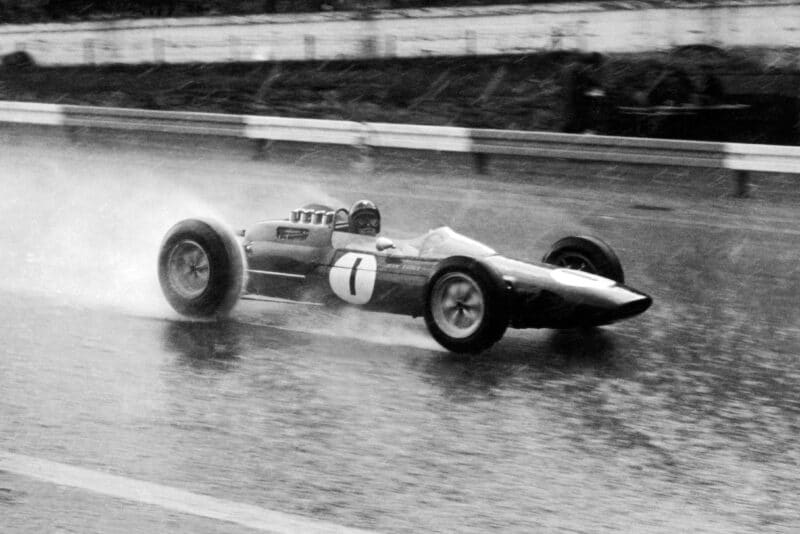
Jim Clark pressing on through the rain in his Lotus 25-Climax.
Motorsport Images
On lap 25 Clark lapped Maggs and was not far behind McLaren, while Gurney was dropping back on the wet roads, and by now the storm was reaching a peak and the cars looked more like speed-boats as they went by. Speeds were down to barely 60 mph in places, either due to the torrential rain or the heavy clouds up on Burnenville, and Clark took 6min 40sec to do his 29th lap, an average of under 80mph Gurney had slowed right down and Clark had lapped McLaren, but the Cooper driver was catching Gurney’s Brabham, unbeknown to the American’s pit for they had been trying to sort Jack’s car out and he had set off on another lap as the heavens had opened, but he soon packed it in, being many laps behind the tail-enders.
Settember called in for dry goggles and went off again, but failed to complete his next lap for he hit a patch of water on the way up from Stavelot and spun helplessly down a bank into a field. On the Masta straight Bianchi hit a similar patch of water and shot through a hedge and hit the side of a house, wrecking the car but getting away unhurt, and Siffert was in similar trouble, his Lotus-BRM being badly damaged. Maggs had an excursion off the road due to being unable to see and he stopped at the pits for more goggles, only to find that he had split his oil radiator, and Bonnier stopped to collect a visor and then splash on into the rain.
While all this was going on Colin Chapman of Lotus and Tony Rudd of BRM were seriously discussing a request to the organisers to stop the race, so bad was the rain, with thunder and lightning still rending the skies. McLaren was profiting from the conditions, his Cooper not feeling too bad on the streaming roads, and on lap 30 he not only passed Clark, to “unlap” himself from the leader, but passed Gurney to take second place. For the last two laps the rain eased off, to finally stop, and there was still a surprisingly large crowd of spectators, soaked to the skin, to greet a tired and wet Clark when he finished his 32nd lap.
Crossing the line at very slow speed, he stopped at once instead of going on for a slowing-down lap, and immediately the crowds swarmed over the track. The remaining runners came straggling in and all stopped straight away, except de Beaufort, who, remembering Rouen last year, stuck to the rule book and did a slowing-down lap. A mere six cars were left running, out of the 20 that started, and it was a wonder that no one was hurt, in spite of some lurid crashes.
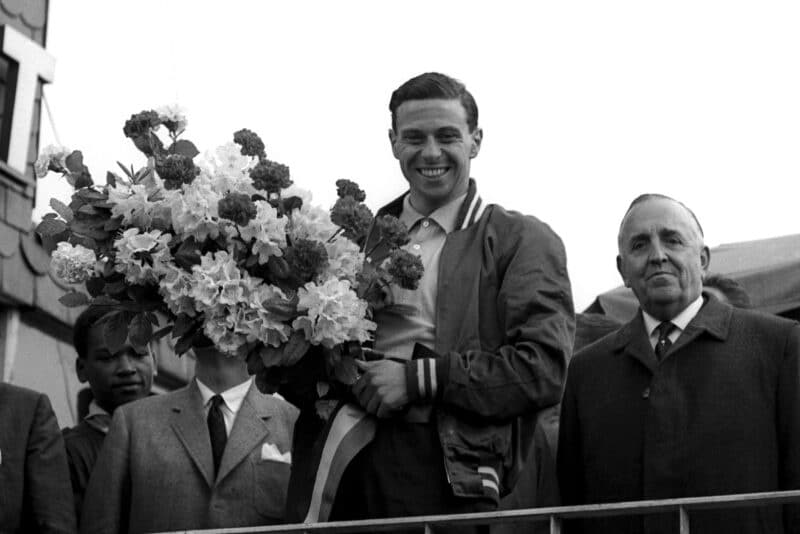
Race winner Jim Clark celebrates victory on the podium.
Motorsport Images
Francorchamps frivolities
- A pity some of the ace-drivers are not as thoughtful as de Beaufort, who used to be the clown of the “circus,” but nowadays drives very well and sensibly.
- Ireland came to rest out on the circuit at one point, stuck in neutral when a bolt fell out of his gear-change. He had an amusing time sitting in the car with the engine running while a spectator tried to kick the selector arm to engage some sort of gear so that he could drive back to the pits.
- Knowing how dicey the Lolas are on very wet roads it was remiss of somebody not to warn Lucien Bianchi about it, this being his first drive in a Lola.
- Funny how both Italian teams blamed their troubles on a part of the car that they did not manufacture. Ferrari blamed Bosch and ATS blamed Colotti. Poor BRM had only themselves to blame.
- The amount of trouble that designers are experiencing operating rear-mounted gearboxes from the cockpits has gone beyond being absurd. It’s time they reverted to front engines and gearboxes in the cockpit with simple gear-levers, or else get down to some scientific hydraulic controls.
- Team Lotus are remarkable; a shambles in practice and then Clark leads the race from start to finish, completely untroubled.
